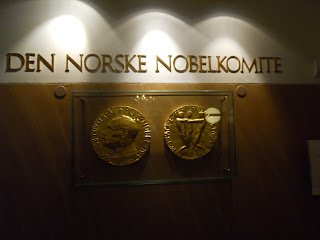 |
| The Center |
While irony is occasionally humorous, in this case, it is only painfully fitting.
We have only recently returned from Norway's Holocaust and Religious Minorities Memorial center. The center, a highly moving and powerful museum of commemoration, displays pictures, diaries, clothing, propaganda posters, and movies from the Holocaust and the Norwegian sufferers of this catastrophe.
We were welcomed with a short lecture on Norway's involvement in the Holocaust. As was the case until the recent immigration diasporas to Norway, the Norwegian people have been almost entirely ethnically homogeneous. In fact, it has been argued that the Nazis truly didn't want to invade the country; the Norwegians provided an a fitting example of the lauded Aryan race. Yet, an invasion did indeed happen. During a series of night missions conducted by German ships and paratroopers, the neutrality of Norway was viciously violated, and the country was taken over. After only several weeks of resistance, the once-proud Norwegian people were subjugated in early summer 1940. The Norwegian monarchs were forced to flee to exile in England, and bitter long years of occupation arose.
However, while this occupation was oppressive to some, it proved to be deadly to the small Jewish population of the country. After pre-war legislation opened the country to immigration by Jews, a small group of them traveled to Norway to start their new lives. Thus, when the Germans invaded, 2100 Jews lived in Norway. Since they were such a small portion of the population, discrimination was limited at first. However, by December 1942, nearly 800 Jews were rounded up and sent to Auschwitz; thankfully, the other 1300 had escaped to Sweden. At Auschwitz, nearly 3/4 of the arriving Norwegian Jews were immediately murdered in the gas chambers. The rest were forced into slave labor. Of the 800 deported from Norway, only 26 survived the war.
Oslo's memorial center does not shirk the blame for this travesty. Although the numbers of Jews arrested and deported was relatively small, the arrests were all conducted by Norwegian police in order to be more thorough, as well as easing the Nazis tasks. After the war, several police commissioners were put on trial for these war crimes; sadly, all were found innocent. However, the museum clearly states the guilt of Norway in her failure to limit the Holocaust.
Although the entire museum was in Norwegian, images do not need translation. Hundreds of arresting images lie in the museum, and tears filled my eyes as I glimpsed once more this terrible picture:
Within the victim's eyes, you can see all sadness that has ever engulfed God's world. Although horrifying, it is important to show. Even now, I feel truly sick looking at the image, but we can never forget what happened here.
The irony I mentioned early lies in the museum's location. It is located in the massive home and estate of Vidkun Quisling, the Norwegian Nazi-collaborator and head of the Norwegian Nazi party. Once used for evil, the home has now been changed for good.
Yet, the museum also focuses on modern tragedies as well. One hall of the memorial was dedicated to the Rwandan genocide. It is also important to remember that the Holocaust is not the only genocide of the world.
As a student of peace in a nation renowned for its peace work, this memorial was powerful and fitfully unsettling. It reminds me why I study peace and the true need for enacting that ideal around the world.










